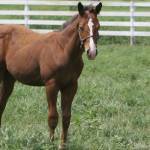Moderate, Steady Growth for Soundness in Young Horses

Management of steady growth in young horses is important for proper bone development. Careful coordination is required among the many functions that end in growth to a body size of five times the human in about one-tenth the time. Proper skeletal development must result in the straightening of any angular limb deformity and must bear a body weight increase of up to two or three pounds per day. Slowed bone formation, resulting in inferior bone quality, can occur if deficiencies or imbalances exist.
One of the most common causes of bone formation derangements is the addition of body weight faster than the bone growth rate can accommodate. The juvenile physis (growth plate) is wide and made up of a thick layer of cartilage. It gradually thins as body size and activity level increase with age. The more distal (lower on the leg) the growth plate, the less its soft tissues are protected by muscles and tendons, and therefore the more vulnerable the physis. As a result, the distal physes close earlier than the more proximal physes.
Human intervention to alter development and form of young sales or halter horses often results in an oversized body on normal-sized limbs. Since physis maturation is primarily time-dependent, acceleration of body growth can overload the physes, which are normally mature and closed prior to attainment of a particular body size. Even though bone formation may be normal, the signs of overload are the same as for poor-quality bone. Normal activity of the horse then becomes traumatic to the growing bone due to sheer body size. Injury to the growing bone can result in pain, structural damage, and osteochondritis dissecans (OCD) if the traumatic insult results in interruption of vascular ingrowth at a localized epiphyseal bone formation site.
Pharmacologic alterations in bone formation rates may also be possible. Extended dexamethasone use has been correlated with the occurrence of OCD. Though speculative, the catabolic effects of corticosteroids may affect the anabolic process of new bone formation. These effects are generally body-wide, but clinical signs become apparent only in the rapid bone formation sites.








